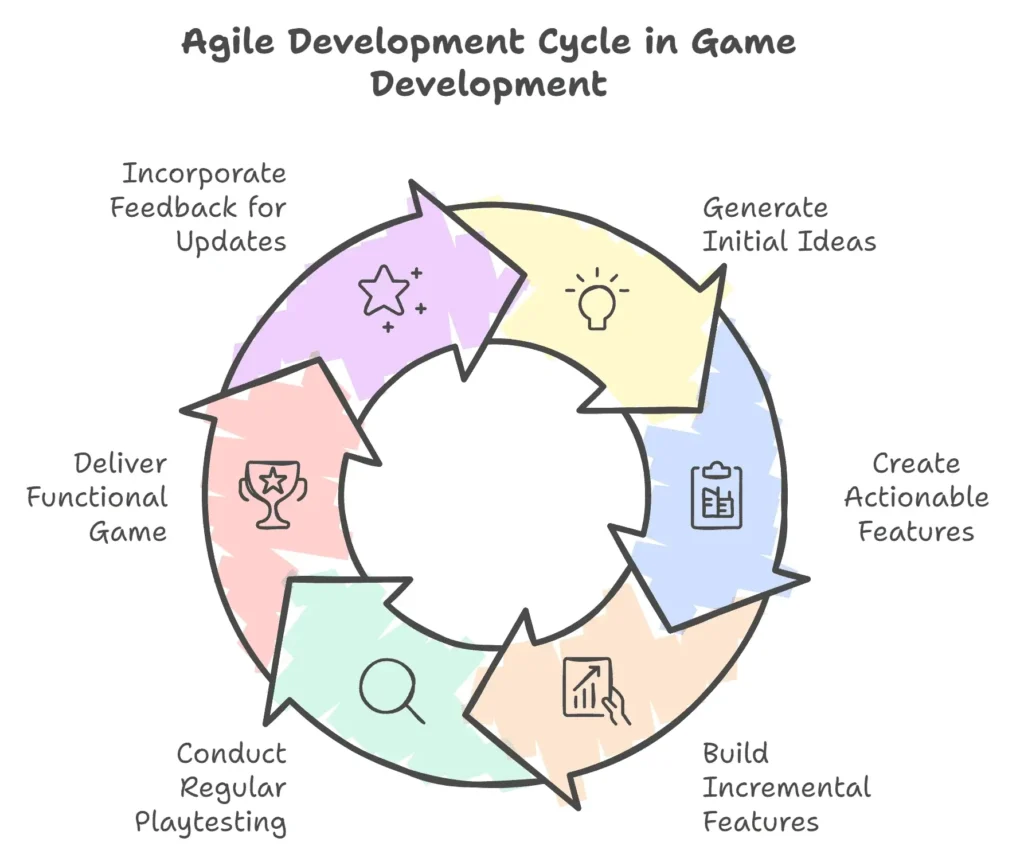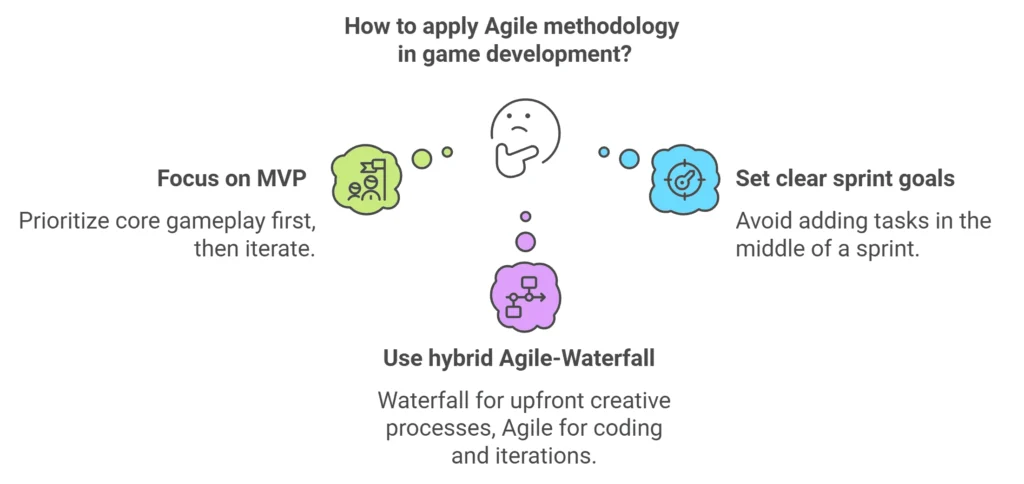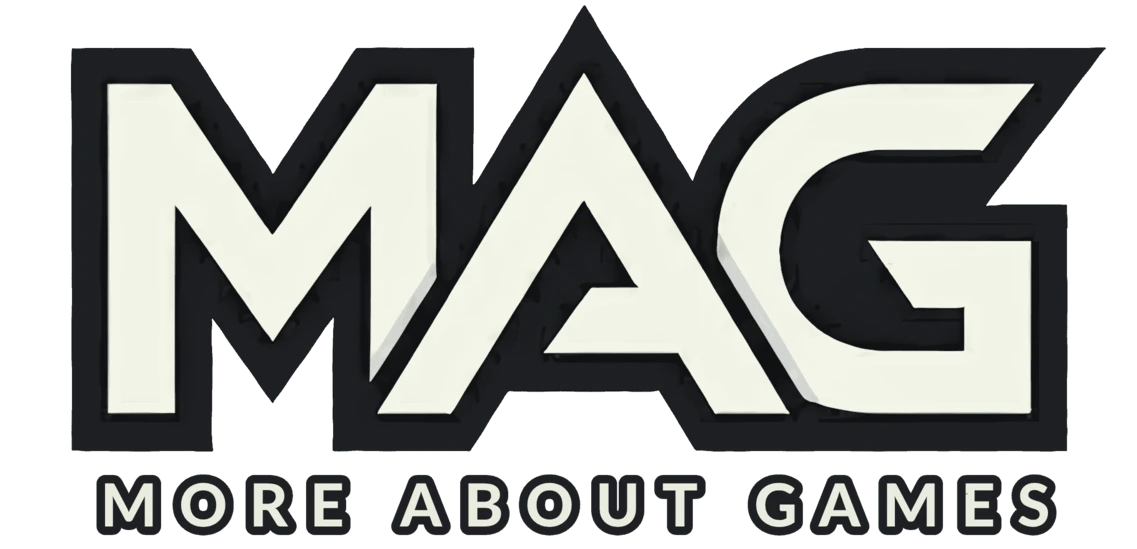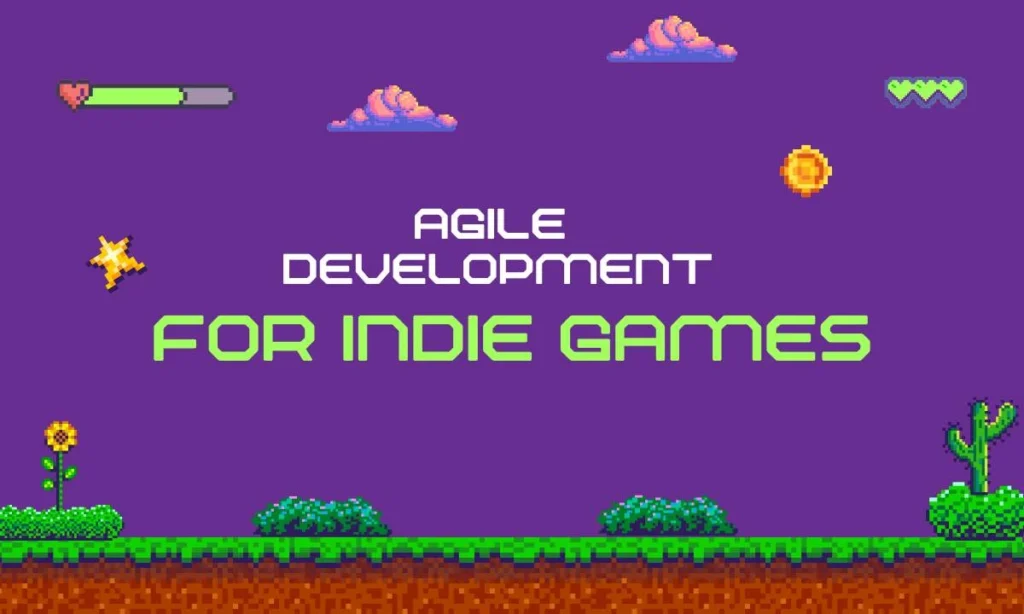The indie game development scene is incredibly competitive, with thousands of titles hitting the market every year. For smaller teams with limited resources, staying ahead of the curve means being adaptable and focusing on delivering value to players as efficiently as possible. This is where agile development for indie game projects comes in.
Originally designed for software development, agile development for indie game creation has transformed the way indie developers approach their craft. By focusing on iteration, collaboration, and responding to feedback, agile helps indie teams stay flexible while ensuring they deliver polished, fun, and market-ready games. In this blog, we’ll dive deep into how agile development works, why it’s a perfect fit for indie developers, and practical steps you can take to implement it successfully in your projects.
Whether you’re working solo or as part of a small team, mastering agile development for indie game projects can make the difference between a chaotic, stressful development process and a streamlined, efficient one that results in a better game for your players.
Key Takeaways
- Agile is perfect for indies: It allows for quick adaptations, continuous feedback, and delivering a playable MVP early on.
- Scrum vs. Kanban:
- Scrum offers structured, time-boxed sprints with defined roles.
- Kanban is more flexible, perfect for small teams or solo devs.
- Improves playability, reduces risk: Frequent playtesting helps refine core mechanics, and sprints keep scope under control.
- Tools are essential: Use Trello, Jira for task management, and Slack, Discord for communication to keep teams organized and aligned.
- Real-world success: Games like Celeste, Hollow Knight, and Dead Cells used Agile to iterate and polish gameplay based on player feedback.
- Watch out for scope creep: Focus on MVP and set clear goals to avoid runaway features or shifting timelines.
- Consider a hybrid approach: For creative tasks like art and storytelling, a mix of Agile and Waterfall can work best.
- Tailor Agile to your team: Whether using Scrum, Kanban, or a hybrid model, adapt Agile principles to fit your project’s unique needs.
What is Agile Development?
Agile Overview
Agile development is an iterative approach to game and software creation where the development process is broken down into small, manageable increments called sprints. These increments allow teams to regularly assess the project’s direction and make necessary changes as they go along, rather than waiting until the end of the development cycle to see the final product. In essence, Agile promotes a flexible, collaborative process where feedback is continuously incorporated to ensure the project meets evolving needs.
Originally formalized in 2001 by the Agile Manifesto (crafted by software engineers who were frustrated with traditional, rigid development practices), Agile has since become the go-to methodology for not just software but game development as well. Agile emphasizes these four core values:
- Individuals and interactions over processes and tools – People are more important than tools or procedures.
- Working software over comprehensive documentation – Deliver a working product regularly, rather than getting bogged down in documentation.
- Customer collaboration over contract negotiation – Actively work with stakeholders and users to adapt to their needs.
- Responding to change over following a plan – Flexibility is more important than sticking to a rigid plan, especially when things change.

How Does Agile Apply to Indie Game Development?
For indie game developers, the Agile methodology fits perfectly. Indie teams, often small and under tight deadlines, need to be able to respond to player feedback and market changes quickly. Agile allows you to iterate on your game by testing and refining mechanics early and often. Instead of going months (or years) building a game that might not work, Agile ensures that you’re always moving toward a more refined and playable product.
By adopting Agile, indie developers can:
- Test gameplay mechanics frequently to avoid wasting time on features that don’t work.
- Deliver an MVP (Minimum Viable Product) early, allowing them to gather feedback from real players.
- Pivot easily when new ideas or market demands arise.
Benefits of Agile for Indie Game Developers
Adopting Agile in indie game development brings several key advantages. Unlike traditional Waterfall methodologies—where you plan everything at the start and work linearly—Agile is more about adaptability, making it ideal for the unpredictable nature of game development.
Flexibility in Development
One of Agile’s biggest advantages is its ability to pivot quickly. Let’s say you spend months designing a complex feature only to realize it doesn’t mesh well with your core gameplay. With traditional methods, this realization might happen too late, after significant time and resources have already been invested. Agile allows you to test ideas early, gather feedback, and make adjustments during the development process, preventing wasted effort on features that might not work.
Why is Flexibility Important for Indie Developers?
In the indie world, it’s common to work with a small team (or even solo), and things can change quickly—whether it’s feedback from players, new trends in the market, or technological advancements. Agile allows you to incorporate changes seamlessly without disrupting the entire workflow.
Focus on Playability
Agile development encourages continuous testing and feedback. This is critical for indie games, where gameplay is king. By playtesting early builds and making iterative improvements, you can ensure the core mechanics of your game are solid long before launch. Since Agile promotes building “working software” at each stage, indie teams can ensure the game is fun and playable at every step of the process.
For example, many developers use Agile to test vertical slices (a small, playable portion of the game) to evaluate whether the core mechanics are engaging. This reduces the risk of spending months on features that don’t actually contribute to the fun factor.
Reduced Risk and Scope Creep
Scope creep—when your project’s scope gradually expands beyond what was originally intended—is a major risk in game development. Agile minimizes this risk by focusing on short, focused sprints. Each sprint has defined objectives, and only after those are achieved can new features or improvements be considered.
By breaking development into short sprints, Agile allows you to:
- Set clear, achievable goals.
- Focus only on essential features.
- Prevent unnecessary additions from bloating your project.
Better Team Collaboration
Agile emphasizes collaboration and communication, which is crucial for small indie teams. Regular team check-ins (often in the form of daily stand-up meetings) ensure everyone is on the same page, and issues can be addressed before they become blockers. In a small team, where each member wears multiple hats, Agile’s focus on communication can help streamline the process and prevent misunderstandings.
Agile vs. Traditional (Waterfall) Game Development
| Feature | Agile Development | Traditional (Waterfall) Development |
|---|---|---|
| Flexibility | High: Can adapt to new feedback quickly | Low: Hard to change once plans are set |
| Iteration | Frequent iterations and playtesting | Usually only tested near the end |
| Risk of Scope Creep | Controlled through short sprints | Higher risk if changes are needed late in the process |
| Player Feedback Integration | Feedback can be incorporated mid-development | Feedback typically only integrated after the product is complete |
| Collaboration | High: Regular communication within the team | Collaboration often happens in set phases, can lead to silos |
| Focus on MVP | Emphasizes delivering a playable product early | Focuses on full-feature release before playtesting |
| Best Use Case | Indie/small teams with evolving projects or mechanics | Large-scale projects with clear, unchanging goals |
Key Agile Methodologies: Scrum vs. Kanban
Agile isn’t a one-size-fits-all solution. Depending on your team size, project complexity, and preferred work style, you’ll want to choose the right Agile framework. Two of the most commonly used frameworks are Scrum and Kanban.
Scrum: A Structured Framework for Defined Roles
Scrum is one of the most widely used Agile methodologies. It breaks the development process into time-boxed periods called sprints (usually lasting 2-4 weeks). Each sprint focuses on delivering a piece of the game that is playable and testable. Scrum also defines specific roles within the team:
- The Product Owner (the person responsible for prioritizing what features get built).
- The Scrum Master (the person who ensures the team follows Agile practices and facilitates the process).
- The Development Team, which does the actual design, coding, and testing.
Benefits of Scrum:
- Clear roles and responsibilities ensure that everyone knows their tasks.
- Regular sprints with set goals prevent scope creep and keep development on schedule.
- Feedback loops are built into the framework, ensuring issues are caught early.
Kanban: A Flexible, Visual Approach
Kanban, on the other hand, is a more flexible Agile methodology that emphasizes visualizing work and limiting the amount of work in progress (WIP). With Kanban, there are no time-boxed sprints. Instead, tasks are continuously moved through stages, usually represented on a board (either physical or digital, like Trello). As work progresses, tasks move from one column to the next (e.g., “To Do,” “In Progress,” “Done”).
Benefits of Kanban:
- Continuous delivery of features and improvements.
- No need for set time periods like sprints, making it easier to adapt to changes.
- Great for small teams or solo developers, as it doesn’t require a lot of structure.
Which Framework Should Indie Developers Choose?
The choice between Scrum and Kanban often comes down to team size and project needs. Scrum is ideal for teams that have defined roles and can work within structured time frames. If your project has clear goals, Scrum can help maintain focus. On the other hand, Kanban is better for smaller teams or solo developers who need flexibility and prefer a continuous flow of tasks over rigid sprints.
| Feature | Scrum | Kanban |
|---|---|---|
| Structure | Time-boxed sprints (e.g., 2-4 weeks) | No fixed time periods, continuous delivery |
| Roles | Defined roles (Product Owner, Scrum Master) | No defined roles; team members work across tasks |
| Task Organization | Sprint Backlog, User Stories, Daily Standups | Kanban Board with “To Do,” “In Progress,” and “Done” |
| Focus | Delivering a specific set of tasks in a sprint | Visualizing tasks and limiting Work In Progress (WIP) |
| Best for | Teams with defined roles, larger teams | Small teams, solo developers, or teams that need flexibility |
| Planning | Detailed planning at the start of each sprint | Tasks are pulled from the backlog when capacity is available |
| Flexibility | Less flexible during sprints (changes must wait for the next sprint) | Very flexible; tasks can be reprioritized at any time |
Hybrid Approach
Many indie developers find success using a hybrid approach, blending Scrum’s structured sprints with Kanban’s flexible task management. For example, you might use Kanban to track overall tasks but still plan key features or milestones in time-boxed sprints.
Essential Tools for Agile Game Development
Implementing Agile successfully in game development requires the right tools. These tools help manage tasks, communicate effectively, and track progress, especially when working with a small or remote team.
Task Management
- Trello: Trello is a popular choice for indie teams using Kanban. It offers a simple drag-and-drop interface to organize tasks into columns like “To Do,” “In Progress,” and “Done.” It’s ideal for small teams or solo developers and is free to use with optional paid upgrades.
- Jira: For those using Scrum, Jira is a powerful tool that offers more advanced project management features. It’s excellent for tracking sprints, assigning tasks, and monitoring progress through detailed reports. Jira is typically better suited for larger teams or projects with more complexity.
Why Task Management Matters:
In Agile, tracking progress is key to maintaining momentum and avoiding bottlenecks. Whether you use Trello, Jira, or another tool, keeping your tasks organized ensures that every sprint or development stage has clear goals and that your team knows what to focus on next.
Communication
- Slack: Agile thrives on collaboration, and Slack has become the go-to tool for team communication. Slack offers real-time messaging, channels for specific topics, and integrations with other tools like Trello or Jira, making it easier to keep everyone aligned.
- Discord: While originally designed for gamers, Discord has found a home with indie developers. It offers voice chat, screen sharing, and text channels, making it great for remote teams or when you need to quickly hop on a voice call to discuss game mechanics or design decisions.
Version Control
- Git/GitHub: Version control is critical in Agile development, especially when multiple team members are working on the same codebase. Git allows developers to track changes, collaborate on features, and roll back if something goes wrong. GitHub, in particular, is a user-friendly platform that integrates Git version control with project management tools like issue tracking and pull requests.
- Perforce: While Git is great for code, Perforce is preferred by teams managing large assets (like 3D models, audio, or high-resolution textures). If your indie project includes massive assets, Perforce might be a better choice for managing files.
Game Development Platforms
- Unity: Unity supports Agile workflows through its rapid iteration features. Developers can create prototypes, iterate on features, and run playtests quickly, making it ideal for teams looking to adopt Agile principles. Unity’s asset store also makes it easy to grab ready-made assets and reduce development time.
- Unreal Engine: Unreal is another popular engine among indie developers. With its visual scripting system (Blueprints), developers can iterate on gameplay mechanics without needing to write code for every small change. This fits perfectly with Agile’s emphasis on rapid prototyping and testing.
Challenges and Solutions When Applying Agile to Indie Game Development
While Agile offers numerous benefits, it’s not without its challenges. Here are some of the most common hurdles that indie game developers face when applying Agile, along with solutions to overcome them.
Common Challenges
- Scope Creep: Agile’s flexible nature can lead to a constant addition of new features, which can derail the project’s timeline if not controlled.
- Difficulty in Predicting Timelines: Because Agile emphasizes flexibility, it can be hard to accurately predict when your game will be finished, especially if priorities shift during development.
- Balancing Creativity with Structure: Game development is a creative process, and sometimes the structure of Agile can feel too restrictive, especially for artists or narrative designers who may need more time to explore ideas.
Solutions
- Focus on a Minimum Viable Product (MVP): To avoid scope creep, indie developers should prioritize creating a Minimum Viable Product (MVP) early on. This is a stripped-down version of the game that focuses only on the core mechanics. Once the MVP is playable, you can build on top of it with additional features and polish, without losing sight of the end goal.
- Set Clear Sprint Goals: Even though Agile allows for flexibility, it’s important to set clear, achievable goals for each sprint. By breaking down big tasks into smaller ones, you can ensure steady progress while keeping the project on track.
- Use a Hybrid Agile-Waterfall Approach: For tasks that require more upfront planning—like art design or narrative development—some teams adopt a hybrid approach. In this model, Agile is used for the development and coding aspects of the project, while the more creative processes follow a Waterfall approach (with pre-defined milestones). This allows for creative exploration without compromising on overall project structure.

Final Thoughts: Is Agile Right for Your Indie Game?
Agile development has proven to be a powerful tool for indie developers who need flexibility, adaptability, and a focus on delivering player-driven value. By breaking down the development process into manageable chunks, you can avoid the pitfalls of scope creep, enhance team collaboration, and deliver a polished game that players will love.
However, Agile is not a silver bullet. It requires commitment, communication, and constant adjustment. You’ll need to find the right balance between structure and creativity, and tailor Agile principles to fit your project’s unique needs.
If you’re ready to experiment with Agile in your next project, start by defining clear goals, selecting the right tools, and fostering open communication within your team. With the right mindset and approach, Agile can help you take your indie game from concept to completion—while staying flexible, efficient, and player-focused.
FAQs
What’s the difference between Scrum and Kanban?
Scrum uses sprints and defined roles, while Kanban is more flexible and focuses on visualizing tasks. Scrum is better for teams with structured roles, while Kanban suits smaller or solo teams.
Can Agile work for solo indie developers?
Yes! Many solo developers use Kanban to track their progress and manage their tasks. The flexibility of Agile allows solo devs to adapt quickly to new ideas or feedback.
How do I prevent scope creep when using Agile?
Prioritize creating an MVP (Minimum Viable Product) early in the development process. Focus on core gameplay mechanics first, and add new features only after the MVP is polished.
What’s a realistic sprint length for an indie game team?
A sprint of 2-4 weeks works well for most indie teams. It allows enough time to make meaningful progress without feeling too rushed.
Do I need specific Agile tools to implement it in game development?
While tools like Jira or Trello can help, Agile is more about the principles and mindset. You can use any project management tool as long as it supports iterative progress and collaboration.



